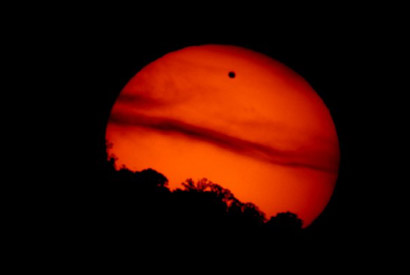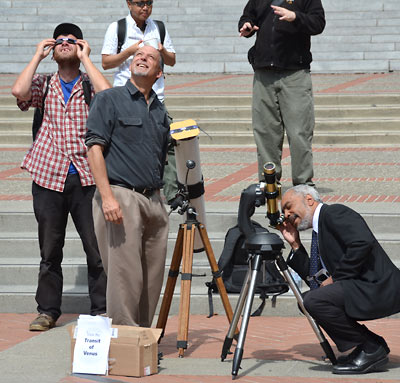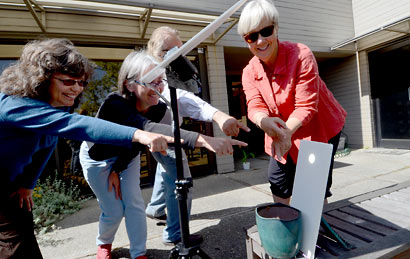Black dot on the sun’s a bright spot for campus stargazers
A rare transit of Venus brought campus astronomers, and many others' inner astronomers, out of doors Tuesday. On Sproul Plaza, hundreds lined up, over the course of five hours, for a last-in-a-lifetime chance to glimpse Venus by day; others viewed the planet from as near as Lawrence Hall of Science or as far away as Hawaii.

June 6, 2012
Venus’s rare transit directly between Earth and the sun on Tuesday brought Berkeley astronomers — and many others’ inner astronomers — out of doors to catch a glimpse.

Astronomers Geoff Marcy (black shirt) and Gibor Basri (black suit) check out the view from Sproul Plaza. (Roibín Ó hÉochaidh photo)
Berkeley astronomy professor Geoff Marcy set up viewing equipment on Sproul Plaza shortly after 3 p.m., when the planet’s transit was first visible from Berkeley. The line quickly grew, as staff, faculty, local community members, even top administrators and deans waited to safely observe a small black spot, Venus, against the bright orb of the sun.
“Can you see it now? You see the red disk and the big black dot?” Marcy asked visitors as they peered through a solar telescope fitted with a hydrogen-filter lens (which turned everything red). “That’s the planet Venus passing across the sun! Isn’t that amazing?”
The transit of Venus won’t happen again for more than a century. So it was likely the last chance for the hundreds of grown-ups who gawked from Sproul, though Marcy held out some hope for a 2-year-old who was there with her dad.
“She won’t remember being here — but we took a photo of her looking through the telescope,” Marcy said. “Maybe in 2117 she’ll be able to tell her grandchildren she was here at Berkeley for the last transit of Venus.”
“I get such a kick out of seeing people get so excited about science,” he added. “This is a great marriage of the aesthetic and the scientific and it’s a whole lot of fun.”

Staff view Venus’s transit using a make-shift device.
The viewing station remained up and running into the evening, when the campus Aztec group In Xochitl In Cuicatl appeared on the plaza, in full regalia, to dance and make ceremonial offerings to Venus — a planet of importance in Aztec culture, said Wendy Ortiz, a performer with a newly minted sociology degree from Berkeley.
Others made the trip up the hill to Lawrence Hall of Science to view the transit through solar telescopes set up on the Hall’s main plaza. For those with less fancy equipment on hand, ingenuity kicked in. Outside the Public Affairs office, designer Hulda Nelson rigged up a pair of binoculars on a tripod stand to project the event on a stiff white board, as co-workers huddled to peer and exclaim.
It’s neat that it’s one of the planets that’s crossing in front of the sun,” said UC Berkeley science writer Robert Sanders (Twitter handle @bobthesciguy). “We can see Venus shining in the sky at night. To see it in daytime, in profile against the sun, is rare and exciting.”
Meanwhile, in Hawaii, Berkeley astronomy professor Alex Filippenko took luminous photos of the transit through the eyepiece of a telescope. “The silhouette of Venus is the big black spot,” he explained in an email. “The other dark spots are sunspots.”
(Reporting from Sproul Plaza by Roibín Ó hÉochaidh)